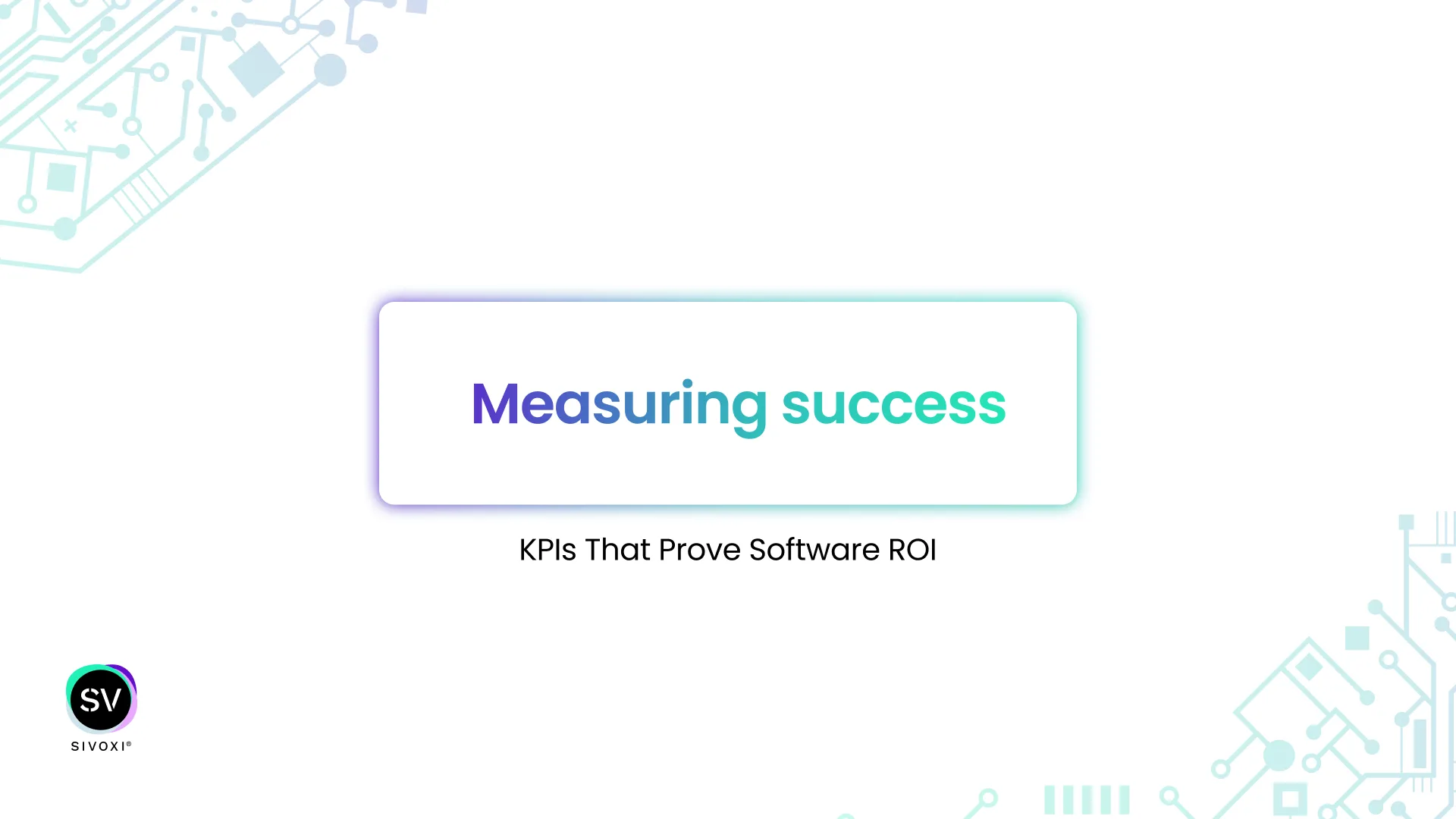Clear Vision and Scope Definition
Clear Vision:
Having a clear vision means understanding the purpose and goals of the custom software development project. It involves answering questions like:
Why are we building this solution?
Defining the core purpose before embarking on a project is crucial. This question helps keep the project focused on solving specific problems.
What are the desired outcomes?
Defining success metrics helps set realistic expectations for the project. Whether they are related to user engagement, revenue generation, or operational efficiency, clear goals help define a project’s success.
Who are the end-users?
Understanding the target audience ensures that the solution will be tailored to the target demographic’s wants and needs.
Scope Definition:
Scope refers to the boundaries and extent of the project. Defining the scope involves determining which features and functionalities will be included in the solution. This step is vital for several reasons:
Preventing Scope Creep:
Scope creep occurs when new features are continuously added to the project without proper evaluation. This can lead to missed deadlines and increased costs. Clearly defining the scope from the start helps prevent this issue.
Resource Allocation:
A well-defined scope allows teams to allocate the appropriate talent and define time and budget. This prevents the over, and under allocation, of resources.
Faster Development:
Developers can focus on building the specified features without distractions. Speeding up development and ensuring that the project stays on schedule.
Quality Control:
A focused scope enables developers to dedicate more time and attention to ensuring the quality of all included features.
Resource Allocation and Time Management
Realistic Expectations:
Setting realistic timelines helps manage stakeholders’ expectations and prevents promises of delivery that can’t be met.
Avoiding Rushed Work:
Rushing to meet an unrealistic deadline can lead to errors, poor quality, and overlooked details. Proper time management allows for thorough work.
Risk Assessment:
Accurate time estimates enable teams to identify potential delays, allowing for proactive risk mitigation strategies.
Resource Coordination:
Knowing when each phase will occur allows for better coordination of resources. For example, design and development teams can align their efforts more effectively.
Scope Control:
Proper time management helps ensure that the scope is completed within the allotted time. If a project is falling behind schedule, adjustments can be made to the scope to keep the project on track.
Quality Assurance:
Testing and quality assurance ensures that the final product is thoroughly tested. Allowing time to ensure the project meets all standards is crucial.
Risk Mitigation
Risk mitigation involves identifying potential challenges, uncertainties, and obstacles that could impact the success of the project. It also involves devising strategies to address or minimize these risks.
Identifying Risks:
Uncertainty in Technology:
Custom software development often involves using new or complex technologies. Risks can arise if the chosen technology is not well understood or lacks proper documentation.
Changing Requirements:
As the project scope and requirements evolve, it can lead to confusion or scope creep, potentially derailing the project.
Resource Shortages:
Insufficient human resources, budget, or tools can hinder progress and lead to delays.
External Dependencies:
If the project relies on third-party APIs, services, or components, any issues on their end can impact the project’s timeline.
Security Concerns:
Vulnerabilities in the software can compromise data security and user privacy. This can lead to reputational damage and legal consequences.
Inadequate Testing:
Skipping thorough testing can result in undetected bugs or issues, leading to post-launch problems.
Benefits of Risk Mitigation:
Reduced Delays:
Addressing risks proactively helps prevent delays that could otherwise occur if issues are discovered late in the project.
Enhanced Quality:
Implementing mitigation strategies ensures that the final product is of higher quality, with fewer bugs and issues.
Cost Savings:
Identifying and addressing risks early can prevent costly rework or last-minute changes.
Stakeholder Confidence:
Demonstrating a thorough understanding of potential risks and having strategies in place to manage them builds stakeholder trust.
Adaptability:
Mitigation plans enable the project to adapt to changing circumstances, making the team more resilient.
Successful Delivery:
Effectively managing risks increases the likelihood of successfully delivering the project on time and within scope.
Quality Assurance and Testing
Quality assurance (QA) involves maintaining and improving the quality of the software throughout its development lifecycle.
Consistency:
QA ensures that consistent development practices are followed resulting in a cohesive and uniform product.
Prevention of Defects:
By identifying potential issues early and implementing preventive measures, QA minimizes the occurrence of defects and errors.
Process Improvement:
Regular QA reviews and assessments lead to process improvements, enhancing efficiency and reducing the likelihood of errors.
Documentation:
Proper documentation of QA processes and procedures ensures that best practices are followed and can be referred to in the future.
Risk Management:
QA strategies address potential risks and vulnerabilities, reducing the chances of security breaches or functional failures.
Testing:
Testing involves systematically evaluating the software to identify defects, errors, or gaps in functionality.
Bug Identification:
Testing helps identify and isolate bugs and ensures that they are fixed before deployment.
User Experience:
Thorough testing ensures that the software functions as intended, providing a seamless and positive user experience.
Compatibility:
Software that works across different devices and operating systems, caters to a broader user base.
Performance:
Performance testing assesses the software’s speed, responsiveness, and stability under various conditions, preventing crashes or slowdowns.
Security:
Security testing safeguards user data by identifying vulnerabilities and weaknesses that could be exploited by malicious actors.
Benefits of Quality Assurance and Testing:
Higher Quality:
QA and testing ensure that the software is free from major bugs and issues, leading to a higher-quality product.
Reduced Costs:
Early bug detection and prevention minimize the cost of fixing issues post-launch.
Enhanced User Experience:
Rigorous testing leads to a seamless user experience, increasing user satisfaction.
Mitigated Risks:
Thorough testing reduces the risk of software failures, security breaches, and functional errors.
Confidence:
QA and testing instil confidence among stakeholders and users that the software is reliable and effective.
Compliance:
Testing ensures that the software meets industry standards and regulatory requirements.
Budget Control
Budget Estimation and Allocation:
Accurate Cost Assessment:
Proper budget control begins with accurately estimating the costs associated with the project. This includes design, development, testing, deployment and any third-party services.
Resource Allocation:
Allocate the budget to different project phases and tasks based on their importance and priority. This prevents overspending on less critical aspects.
Contingency Fund:
Set aside a portion of the budget for unforeseen expenses or changes in scope. This contingency fund acts as a safety net to prevent budget overruns.
Benefits of Effective Budget Control:
Stakeholder Trust:
Keeping the project within budget builds trust among stakeholders by demonstrating proper project management.
Resource Optimization:
Efficient budget management ensures that resources are used optimally, reducing waste and unnecessary spending.
Predictable Costs:
Effective budget control prevents sudden cost spikes that could strain the organization’s finances.
Higher ROI:
By prioritizing valuable features and controlling costs, the project can deliver a higher return on investment.
Scalability and Future-Proofing
Scalability:
Scalability refers to a system’s ability to handle increasing workloads and demands without sacrificing performance, reliability, or user experience. It’s a critical consideration because it ensures that the software can accommodate growth and changes over time. Here’s why scalability matters:
Business Growth:
As businesses expand, their software needs to handle larger user bases, increased data, and higher traffic without slowdowns or crashes.
User Experience:
Scalability ensures that the software remains responsive and provides a seamless user experience, even as the number of users grow.
Cost Efficiency:
Scalable systems can accommodate growth without requiring major architectural changes, resulting in cost savings in the long run.
Adapting to Demand:
During peak usage periods, scalable software can allocate resources dynamically to handle increased demand, preventing performance issues.
Future-Proofing:
Future-proofing involves designing and developing software with an eye on long-term viability. It anticipates changes in technology and business requirements to ensure the software remains relevant and effective over time. Here’s why future-proofing is important:
Technology Evolution:
Technology evolves rapidly. Future-proofing allows the software to adopt new technologies and frameworks without complete overhauls.
Changing Requirements:
Business needs and user preferences change. A future-proof system can adapt to new requirements without starting from scratch.
Cost Savings:
Developing software that can be easily updated or extended reduces the cost of rebuilding from the ground up in the future.
Extended Lifecycle:
Futureproofing extends the software’s lifespan, reducing the frequency of major redevelopments.
In the world of custom software development, the adage “Failing to plan is planning to fail” rings particularly true. The benefits of planning cannot be overstated. Planning is the foundation upon which successful custom software development projects are built.
Planning is the compass that guides development teams towards creating effective, efficient, and innovative solutions that align with the unique needs of businesses and users alike.
Before embarking on your next custom software development journey, remember the power of planning and set the stage for success.
If you’re interested in creating custom software solutions for your business, feel free to contact us here.
Alternatively, feel free to email us at: tech@sivoxi.com
Or call us at +27 60 803 9067 Mon-Fri: 08h00-17h00 CAT











